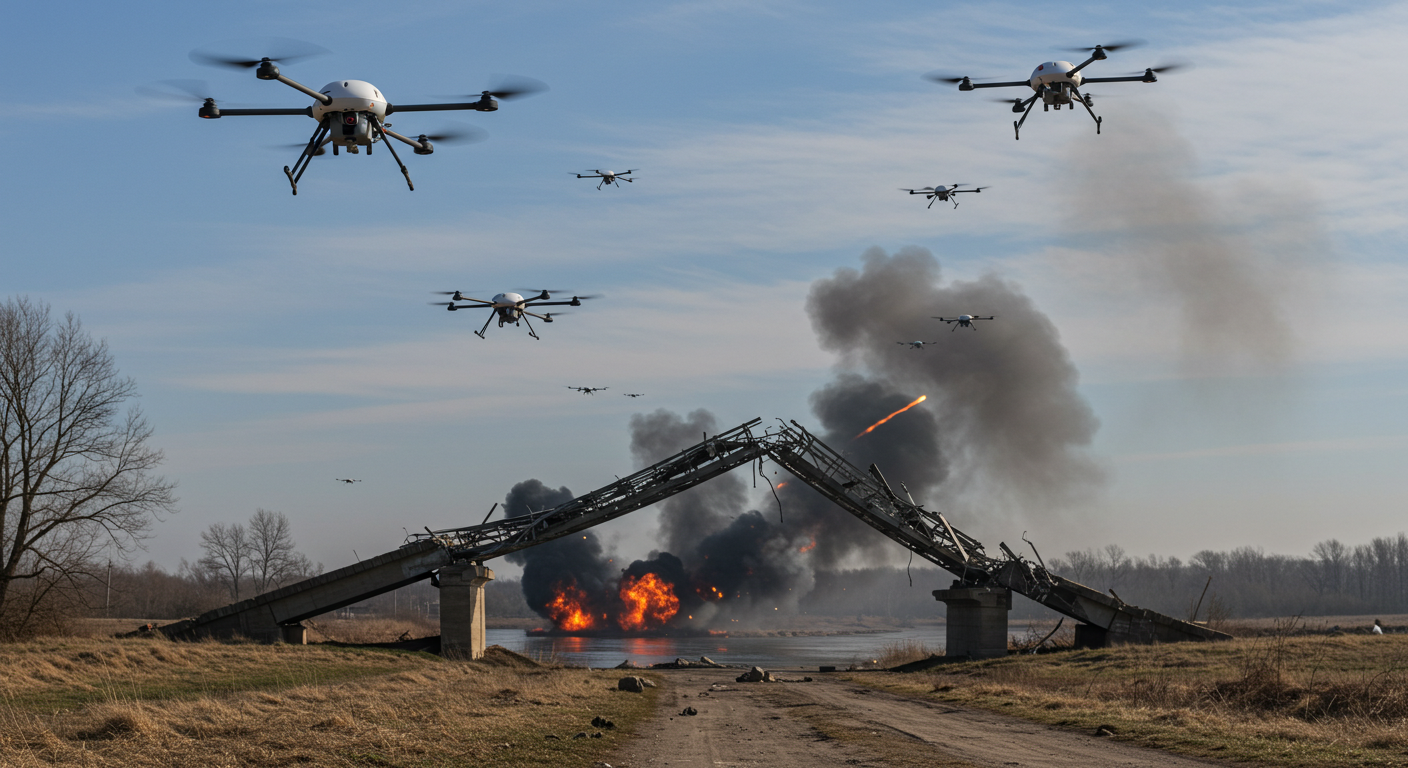Understanding the Development of Ukraine’s Drone Warfare Strategy
In recent years, Ukraine has become a front-runner in the use of drone technology for military purposes, particularly against Russian forces. Amidst ongoing conflict, the Eastern European nation has leveraged drones to strike at critical infrastructure. Among the most notable targets have been Russian bridges, which serve as essential supply routes. This article delves into how Ukraine has mastered drone warfare to effectively take down these vital structures.
1. Historical Context of Drone Warfare in Ukraine
Ukraine began integrating drones into its military strategy during the early stages of the Russo-Ukrainian conflict in 2014. Initially, the focus was on surveillance, utilizing drones to gather intelligence on enemy movements. Over time, advancements in drone technology allowed Ukrainian armed forces to transition from reconnaissance to offensive operations. By 2022, armed drones had become essential components of Ukraine’s battlefield strategy.
2. The Technical Evolution of Ukrainian Drones
Ukraine has benefited from both indigenous drone manufacturing and the acquisition of foreign drones. The purchase of Turkish Bayraktar TB2 drones in 2019 marked a significant enhancement in Ukraine’s capabilities. These drones, equipped with precision-guided munitions, enable long-range strikes while maintaining a stealthy profile. This technological enhancement not only improved operational effectiveness but also instilled confidence in Ukrainian military tactics.
3. Targeting Critical Infrastructure
Bridges play a crucial role in military logistics by facilitating the movement of troops and supplies. The destruction of these structures disrupts enemy operations. Ukraine’s military strategy has increasingly emphasized targeting bridges, particularly those integral to Russian supply lines. The targeting of the Crimean Bridge, a vital route for Russian supplies, exemplifies Ukraine’s strategic focus.
4. Tactical Innovations in Engaging Bridges
Ukraine’s approach to attacking bridges involves a combination of strategy, technology, and intelligence. The use of drones for precision strikes allows for targeting key structural components, ensuring that even smaller drones can achieve impactful results. Ukrainian forces often deploy swarming tactics, where multiple drones simultaneously target a specific bridge. This overwhelming assault complicates Russian defenses and increases the likelihood of successful strikes.
5. Intelligence and Planning
Successful drone operations hinge on meticulous planning and intelligence gathering. Ukraine has invested in reconnaissance missions to map out bridge locations and identify vulnerable points. Signals intelligence (SIGINT) and imagery intelligence (IMINT) are heavily utilized to monitor Russian troop movements and logistical activities around these bridges. Ukraine’s effective use of intelligence helps to ascertain optimal timing for attacks, maximizing the chances of damaging or destroying bridges before they can be defended.
6. Collaboration with International Allies
International partnerships have played a crucial role in enhancing Ukraine’s drone capabilities. Collaborations with countries such as the United States and Turkey have provided technological and tactical support. Training programs and shared intelligence have empowered Ukrainian forces to navigate drone warfare more effectively. Furthermore, the provision of advanced drone systems has bolstered Ukraine’s operational readiness and capabilities in executing missions against Russian infrastructure.
7. Psychological Warfare and Impact on Morale
Beyond the physical destruction of bridges, drone warfare serves as a tool for psychological warfare. Images and videos of successful drone strikes, widely disseminated via social media, contribute to diminishing Russian morale. Ukrainian drone attacks can instill fear among Russian troops and civilians, highlighting vulnerabilities. The psychological component further amplifies the strategic importance of successful drone operations targeting bridges.
8. The Role of Commercial Drones
While military-grade drones are vital, Ukraine has also embraced commercial drone technology. UAVs such as DJI drones, equipped with minimal modifications, have been adapted for reconnaissance and even offensive operations. Their relatively low cost allows for widespread use, and their accessibility democratizes drone warfare, enabling smaller units to engage in meaningful strikes against larger enemy forces.
9. Countermeasures and Response from Russia
In response to Ukraine’s effective drone strikes, Russia has sought to develop countermeasures. These include enhanced air defense systems and electronic warfare tactics aimed at jamming GPS signals and disabling drones. However, Ukraine’s innovative tactics have made it challenging for Russia to completely neutralize these threats. Continuous adaptation and learning from past operations have allowed Ukraine to stay ahead of Russian counter-initiatives.
10. Future Developments in Drone Warfare
As Ukraine continues to adapt its military strategies, drone warfare is expected to play an increasingly prominent role. Future iterations of drone technology will likely focus on enhancing stealth capabilities, increasing payloads, and improving artificial intelligence for better target recognition. Moreover, the ongoing evolution of drone tactics will likely focus on integrating drone operations with manned units, creating a more responsive and agile force.
11. Case Study: Specific Bridge Attacks
One notable instance of Ukraine’s drone warfare effectiveness occurred during the attack on the Crimean Bridge in October 2022. Ukrainian forces successfully launched a coordinated drone assault that resulted in significant damage to the bridge structure. Using both armed UAVs and commercial drones, the operation exemplified the strategic strike against a high-profile target, showcasing Ukraine’s operational capabilities and initiative.
12. Implications for Modern Warfare
The Ukrainian experience with drone warfare underscores the changing landscape of conflict. The effectiveness of drones in attacking infrastructure raises questions about traditional military strategies and the future combat paradigm. As demonstrated by Ukraine, mastery of drone technology can provide smaller or outmatched forces the means to execute significant military objectives, shifting the balance in conflict.
13. The Role of Public Perception and Media
The global media’s coverage of Ukraine’s drone warfare significantly enhances its perception as a technologically capable adversary. Footage showing successful strikes has been pivotal in garnering international support, as potential allies observe Ukraine’s capabilities firsthand. This visibility not only serves to boost Ukrainian morale but also legitimizes its operational strategies on an international stage.
14. Legal and Ethical Considerations
The use of drones in warfare raises important legal and ethical questions, particularly concerning civilian safety and collateral damage. Ukraine is committed to pursuing operations that minimize civilian casualties, prompting debates about the applicability of warfare laws in the age of drones. The ease of deploying drones poses challenges for adherence to international humanitarian principles, making proper oversight and regulations essential.
15. Conclusion: The Future Is in the Sky
From historical precedents to technological advancements, Ukraine’s drone warfare strategy reflects a comprehensive understanding of modern military dynamics. The ability to target strategic infrastructure like bridges showcases the impact of innovation in contemporary warfare. Going forward, the evolution of drone technology and tactics will likely redefine the parameters of conflict, amplifying the lessons learned from Ukraine’s ongoing experiences in this arena.



